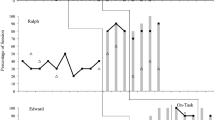Abstract
The present analysis was conducted to validate an automated measurement system of noise violations by participants in the therapeutic workplace, which is a model workplace that offers paid employment and vocational training programs to illicit drug users. We collected data on dB levels via an electronic dB meter in a computer classroom with many different sound sources, and defined noise violations as sounds exceeding 55 dB. Human observers recorded whether staff or participants were responsible for violations, the types of events that resulted in violations, and whether these events were a result of participant behavior. Our analyses revealed that participants caused the majority of noise violations. These results suggest that the automated measurement system collects valid data on participant behavior that contributes to noise violations. Our results also suggest that these behaviors can in principle be modified to reduce the frequency of noise violations. Suggestions for replication in other settings and interventions designed to reduce behaviors leading to noise violations involving feedback and incentives are discussed.
Similar content being viewed by others
References
Alvero, A., Bucklin, B., & Austin, J. (2001). An objective review of the effectiveness and essential characteristics of performance feedback in organizational settings. Journal of Organizational Behavior Management, 21, 3–29.
Carpenedo, C. M., Needham, M., Knealing, T. W., Kolodner, K., Fingerhood, M., Wong, C. J., & Silverman, K. (2007). Professional demeanor of chronically unemployed cocaine-dependent methadone patients in a therapeutic workplace. Substance Use & Misuse, 42, 1141–1159.
Christ, T. J., & Christ, J. A. (2006). Application of an interdependent group contingency mediated by an automated feedback device: An intervention across three high school classrooms. School Psychology Review, 35, 78–90.
Gupta, P., Mittal, L., Rizzo, R. A., Bikkina, M., & DeBari, V. A. (2009). In-use comparison of blood pressure measurements from an automated blood pressure instrument with those from a mercury sphygmomanometer. Biomedical Instrumentation & Technology, 43, 158–163.
Occupational Safety and Health Administration. (1999). Measuring Exposure: OSHA Directive TED 01-00-015 [TED 1–0.15A]. Retrieved from Occupational Safety and Health Administration: http://www.osha.gov
Packard, R. G. (1970). The control of “classroom attention”: A group contingency for complex behavior. Journal of Applied Behavior Analysis, 3, 13–28.
Panos, R., & Freed, T. (2007). The benefits of automatic data collection in the fresh produce supply chain. IEEE International Conference on Automation Science and Engineering (pp. 1034–1038). Piscataway, NJ: Institute of Electrical and Electronics Engineers.
Pawlaczyk-Łuszczyńska, Szymczak, Dudarewicz, Śliwińska-Kowalska, M. (2006). Proposed criteria for assessing low frequency noise annoyance in occupational settings. International Journal of Occupational Medicine and Environmental Health, 19, 185–197.
Pierce, A. D. (1989). Acoustics: An introduction to its physical principles and applications. Melville, NY: Acoustical Society of America.
Schmidt, G. W., & Ulrich, R. E. (1969). Effects of group contingent events upon classroom noise. Journal of Applied Behavior Analysis, 2, 171–179.
Sigurdsson, S. O., Defulio, A., Long, L., & Silverman, K. (in press). Propensity to Work Among Chronically Unemployed Adult Drug Users. Substance Use and Misuse.
Silverman, K. (2004). Exploring the limits and utility of operant conditioning in the treatment of drug addiction. Behavior Analyst, 27, 209–230.
Silverman, K., Wong, C. J., Needham, M. J., Diemer, K. N., Knealing, T. W., Crone-Todd, D., Fingerhood, M., Nuzzo, P., & Kolodner, K. (2007). A randomized trial of employment-based reinforcement of cocaine abstinence in injection drug users. Journal of Applied Behavior Analysis, 40, 387–410.
Tafalla, R. J., & Evans, G. W. (1997). Noise, physiology, and human performance: The potential role of effort. Journal of Occupational Health Psychology, 2, 148–155.
Taylor, W., Melloy, B., Dharwada, P., Gramopadhye, A., & Toler, J. (2004). The effects of static multiple sources of noise on the visual search component of human inspection. International Journal of Industrial Ergonomics, 34, 195–207.
Wright, K. B. (2005). Researching Internet based populations: Advantages and disadvantages of online survey research, online questionnaire authoring software packages, and web survey services. Journal of Computer-Mediated Communication, 10(3), article 11. Retrieved from http://jcmc.indiana.edu/vol10/issue3/wright.html
Yu, E., Moon, K., Oah, S., & Lee, Y. (in press). An examination of the effects of immediate and continuous feedback on safe sitting postures using an automated observation and feedback system. Journal of Organizational Behavior Management.
Author information
Authors and Affiliations
Rights and permissions
About this article
Cite this article
Sigurdsson, S.O., Aklin, W., Ring, B.M. et al. Automated Measurement of Noise Violations in the Therapeutic Workplace. Behav Analysis Practice 4, 47–52 (2011). https://doi.org/10.1007/BF03391774
Published:
Issue Date:
DOI: https://doi.org/10.1007/BF03391774




